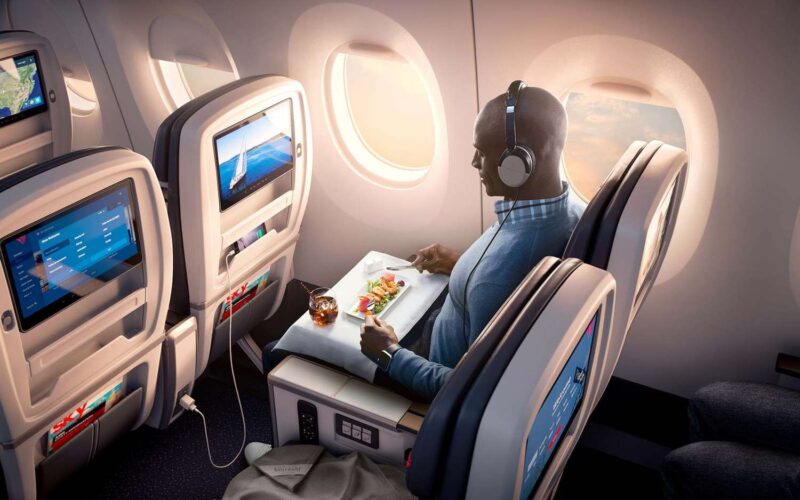Comparing Passenger Experiences on Ultra Long-Haul Flights Across Airlines

Ultra-long-haul flights have transformed air travel, allowing passengers to reach distant destinations in significantly reduced flight times. Airlines are continually improving the passenger experience on these extended journeys, considering factors such as comfort, amenities, and health considerations. Let’s delve into how airlines are approaching the ultra-long-haul passenger experience.
In the 1930s, Imperial Airways operated the historic Kangaroo Route, which was a significant air journey from the United Kingdom to Brisbane, Australia. This route covered a distance of over 10,000 miles and required multiple stopovers along the way. The exact duration and number of stops varied depending on various factors, such as aircraft performance, weather conditions, and logistical considerations. However, completing the Kangaroo Route typically took around 12 and a half days, including overnight breaks at several destinations. It was a lengthy and challenging voyage compared to the nonstop options available in modern air travel.
Today, numerous scheduled routes exceed 8,500 nautical miles, lasting 15 to 19 hours. These flights test the endurance of passengers, requiring airlines to prioritize their comfort and well-being.
Qantas is set to introduce Project Sunrise, enabling nonstop flights from Sydney to London and New York. This ambitious project, utilizing the Airbus A350-1000, exemplifies the advancements in aircraft range and efficiency.
Turkish Airlines aims to establish flights to Australia, while Qatar Airways is resuming its nonstop route between Doha and Auckland. These initiatives highlight airlines’ interest in expanding their reach to more distant destinations.
Operating ultra-long-haul flights presents unique challenges for airlines as they strive to ensure passenger comfort, product differentiation, and well-being during extended hours in-flight. Cabin design, air quality, and onboard amenities play crucial roles in addressing these challenges. To keep passengers entertained and comfortable, airlines employ various strategies:
- Some airlines offer comprehensive inflight services with an emphasis on providing more high-quality meals and a range of amenities.
- In-flight entertainment systems are equipped with a wide selection of movies, TV shows, music, games, and podcasts to keep passengers entertained throughout the journey.
- Airlines are designing new cabins that prioritize passenger comfort, with features like increased legroom, recline, and seat width, especially for economy class passengers.
- Social zones are being introduced on some ultra-long-haul flights, providing passengers with areas to work, relax, stretch, and socialize with fellow travelers.
As the demand for ultra-long-haul travel grows, airlines aim to deliver exceptional passenger experiences by enhancing comfort, convenience, and overall well-being. These efforts make extended journeys more enjoyable for travelers venturing on these remarkable feats of aviation. Related article: The Best First Class in the Sky.
However, it’s important to note that not all airlines offer the same level of amenities on their ultra-long-haul flights. Let’s take a close look at how five airlines offering flights of longer than 15 hours are approaching the ultra-long-haul passenger experience:
Singapore Airlines
Singapore Airlines, a renowned flag carrier, operates two of the world’s longest scheduled flights, connecting Singapore to the New York City area. With a rich history and occasional suspensions, these nonstop routes have captivated travelers for nearly two decades. Let’s explore the remarkable journey of Singapore Airlines’ ultra-long-haul flights.
Qantas
Qantas, an iconic Australian carrier, is at the forefront of ultra-long-haul flight developments, driven by the geographical challenges it faces. With the upcoming Project Sunrise, set to launch in 2025, Qantas aims to create the world’s longest commercial air route, surpassing the Singapore to New York route. Let’s explore what this ambitious project entails and what passengers can expect from Qantas’ ultra-long-haul flights.
Air New Zealand
Air New Zealand has established itself as a leading player in the realm of ultra-long-haul flights, demonstrating a proactive approach to enhancing the passenger experience across all cabin classes. From innovative seating options to revolutionary sleeping pods, the airline has introduced remarkable solutions to mitigate the challenges of extended very long flights.
Emirates
Emirates, the Dubai-based airline renowned for its ultra-long routes, operates its longest flight to date: a remarkable 8,800-mile journey from Dubai to Auckland (AKL), New Zealand. While the primary aircraft on this route is the Airbus A380-800, there have been instances where the Boeing 777-200LR has been deployed.
Air India
Air India caters to the growing traffic between India and Silicon Valley, offering one of the world’s longest flights: Bengaluru (BLR) to San Francisco (SFO). Operated by a Boeing 777-200LR, this approximately 17-hour journey takes a polar route over the Himalayas, Siberia, and the Arctic, providing a unique and scenic experience.
